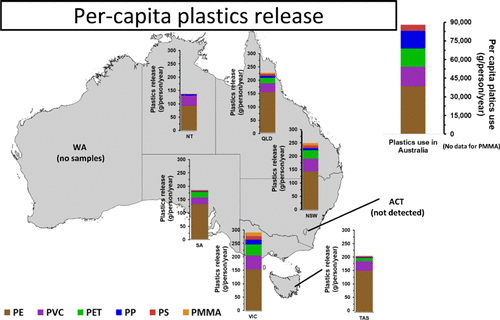当前位置:
X-MOL 学术
›
Environ. Sci. Technol.
›
论文详情
Our official English website, www.x-mol.net, welcomes your
feedback! (Note: you will need to create a separate account there.)
Release of Plastics to Australian Land from Biosolids End-Use
Environmental Science & Technology ( IF 10.8 ) Pub Date : 2020-11-17 , DOI: 10.1021/acs.est.0c05867 Elvis D. Okoffo 1 , Benjamin J. Tscharke 1 , Jake W. O’Brien 1 , Stacey O’Brien 1 , Francisca Ribeiro 1, 2 , Stephen D. Burrows 1, 2 , Phil M. Choi 1 , Xianyu Wang 1 , Jochen F. Mueller 1 , Kevin V. Thomas 1
Environmental Science & Technology ( IF 10.8 ) Pub Date : 2020-11-17 , DOI: 10.1021/acs.est.0c05867 Elvis D. Okoffo 1 , Benjamin J. Tscharke 1 , Jake W. O’Brien 1 , Stacey O’Brien 1 , Francisca Ribeiro 1, 2 , Stephen D. Burrows 1, 2 , Phil M. Choi 1 , Xianyu Wang 1 , Jochen F. Mueller 1 , Kevin V. Thomas 1
Affiliation

|
Plastics are contaminants of emerging concern that can enter the environment from multiple sources, including via land application of treated sewage sludge (biosolids). Biosolids samples collected from 82 wastewater treatment plants (WWTPs) across Australia and covering 34% of the population during census week in 2016 were quantitatively analyzed to estimate the release of seven common plastics. Quantitative analysis was performed by pressurized liquid extraction followed by double-shot microfurnace pyrolysis coupled to gas chromatography mass spectrometry. Ninety nine percent of the samples contained plastics (Σ6plastics) at concentrations of between 0.4 and 23.5 mg/g dry weight (median; 10.4 mg/g dry weight), while polycarbonate was not detected in any sample. Per-capita mass loads of plastics (Σ6plastics) released were between 8 and 877 g/person/year across all investigated WWTPs. Polyethylene was the predominant plastic detected, contributing to 69% of Σ6plastics. Based on the concentrations measured, it was projected that around 4700 metric tons (Mt) of plastics are released into the Australian environment through biosolids end-use each year, equating to approximately 200 g/person/year, which represents 0.13% of total plastics use in Australia. Of this, 3700 Mt of plastics are released to agricultural lands and 140 Mt to landscape topsoil. Our results provide a first quantitative per-capita mass loads and emission estimate of plastic types through biosolids end-use.
中文翻译:

从生物固体最终用途向澳大利亚土地释放塑料
塑料是人们日益关注的污染物,可以通过多种途径进入环境,包括通过土地施用处理过的污泥(生物固体)。2016年普查周期间,从澳大利亚82个废水处理厂(WWTP)收集的生物固体样品进行了定量分析,以估算7种常见塑料的释放量,该样品覆盖了34%的人口。定量分析是通过加压液体萃取,然后用双峰微炉热解与气相色谱质谱联用进行的。样品的百分之九十九包含塑料(Σ 6在0.4和23.5之间毫克/克干重的浓度的塑料)(中位数; 10.4毫克/克干重),而在任何样品中没有检测到聚碳酸酯。人均塑料负荷(Σ在所有调查的污水处理厂中,释放出的6种塑料在8至877克/人/年之间。聚乙烯是主要的塑料检测,有助于的Σ69%6塑料。根据测量的浓度,预计每年通过生物固体最终用途向澳大利亚环境释放约4700公吨(Mt)塑料,相当于约200克/人/年,占塑料总量的0.13%在澳大利亚使用。其中,有3700吨的塑料被释放到农田,140吨的塑料被释放到景观表土。我们的结果提供了第一个定量的人均质量负荷和通过生物固体最终用途对塑料类型的排放估算。
更新日期:2020-12-01
中文翻译:

从生物固体最终用途向澳大利亚土地释放塑料
塑料是人们日益关注的污染物,可以通过多种途径进入环境,包括通过土地施用处理过的污泥(生物固体)。2016年普查周期间,从澳大利亚82个废水处理厂(WWTP)收集的生物固体样品进行了定量分析,以估算7种常见塑料的释放量,该样品覆盖了34%的人口。定量分析是通过加压液体萃取,然后用双峰微炉热解与气相色谱质谱联用进行的。样品的百分之九十九包含塑料(Σ 6在0.4和23.5之间毫克/克干重的浓度的塑料)(中位数; 10.4毫克/克干重),而在任何样品中没有检测到聚碳酸酯。人均塑料负荷(Σ在所有调查的污水处理厂中,释放出的6种塑料在8至877克/人/年之间。聚乙烯是主要的塑料检测,有助于的Σ69%6塑料。根据测量的浓度,预计每年通过生物固体最终用途向澳大利亚环境释放约4700公吨(Mt)塑料,相当于约200克/人/年,占塑料总量的0.13%在澳大利亚使用。其中,有3700吨的塑料被释放到农田,140吨的塑料被释放到景观表土。我们的结果提供了第一个定量的人均质量负荷和通过生物固体最终用途对塑料类型的排放估算。










































 京公网安备 11010802027423号
京公网安备 11010802027423号